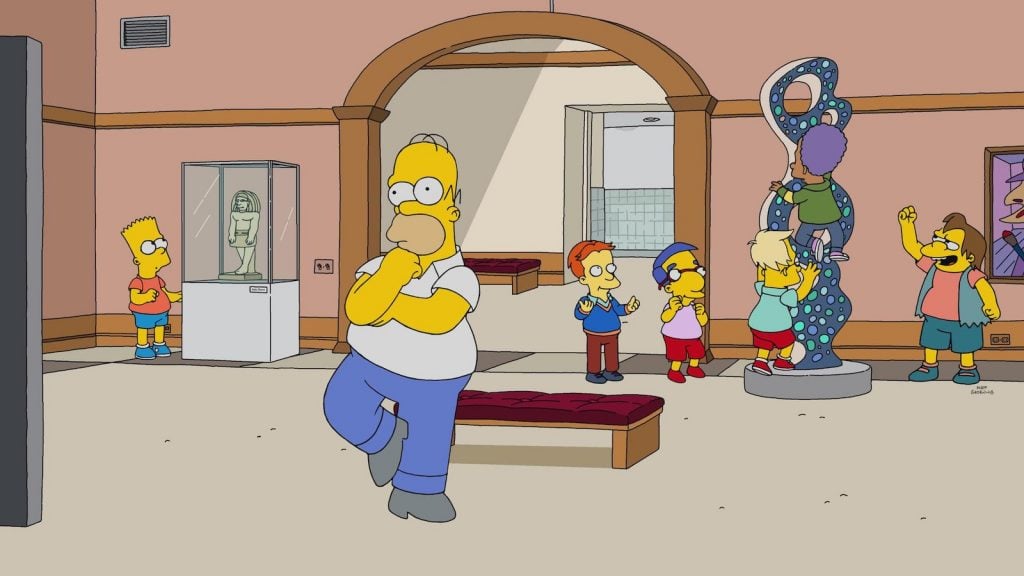Pop Culture
For Decades, ‘The Simpsons’ Has Made Surprisingly Incisive Observations About Art. Here Are 4 That Still Resonate Today
The long-running sitcom has such wise lessons on the art world, it ought to be on art school curricula.

The long-running sitcom has such wise lessons on the art world, it ought to be on art school curricula.

Brian Boucher

You may think of The Simpsons as one of the funniest, most influential and most irreverent animated series of all time, and you wouldn’t be wrong. What you might not know is that the series’ writers have often surveyed the art world—and their takes on it remain incisive.
Fans gathered this spring at New York’s Galerie Eva Presenhuber for a screening of art-themed episodes, organized by New York curator/writer Lola Kramer and Oskar Weiss of Basel gallery Weiss Falk. The event presented a delightful match between content and venue.
Created by cartoonist Matt Groening and airing since 1989, The Simpsons is both the longest-running American animated series and the longest-running U.S. sitcom, and concludes its 34th season this spring.
“The Simpsons are important because it’s about art imitating life,” Kramer said in an email. “And the episodes that Oskar and I selected are about art imitating life imitating art.
“The show feels important to me because I recognize it as a sophisticated use of satire,” she added. “Why is satire important? Look it up!”
Four of the show’s observations on the art world remain current today.
Tastes change faster than Homer can build a BBQ pit
In arguably the best art-themed episode, “Mom and Pop Art” (1999), Homer tries to build a backyard BBQ pit but ends up with a deranged sculpture. Area art dealer Astrid Weller (Isabella Rossellini) dubs Homer an outsider artist and shows the piece, which sells to wealthy Mr. Burns.
“My first sale! In your face, Jasper Johns!” Homer yelled at the artist (in a guest appearance).
But when the pieces at his debut solo echo his first work, the crowd is unimpressed. Said a confused Homer: “You weirdos love this stuff!” But taste is fickle, as multiple artists and collectors are learning today.
Freedom of expression is the champion of “Itchy & Scratchy Marge” (1990). When toddler Maggie assaults Homer after viewing too many violent “Itchy & Scratchy” cartoons, Marge successfully crusades to cancel the show.
But her fellow-censors go too far when they want to cancel a Springfield appearance of Michelangelo’s David. Said one: “It depicts parts of the human body which, practical as they may be, are evil.”
Marge realizes you can’t censor the art you hate, because others will censor the art you love.
The episode aired a few years after Tipper Gore made a federal case out of risque lyrics in rock music, but censorship remains a hot issue today—even when it comes to David.
“It felt even more timely, and laughable, and a little unnerving, when I saw the headline ‘Florida Principal Out After Viewing Of Michelangelo’s David Upsets Parents’ appear the same week that we did the screening,” said Kramer.
Leave it to the Simpsons to let a fraud deliver the deepest wisdom in “The War of Art” (2014).
After the Simpsons buy a painting at a friend’s yard sale, they find the signature of “prolific early 20th-century naturalist” Johan Oldenveldt, and Gavelby’s auction house estimates it at $100,000. The town is divided: should they share the proceeds?
But when Homer and Lisa investigate the landscape’s provenance, they find the real painter, Klaus Ziegler (Max von Sydow). “Forger is such a cruel word,” he said. “I’m an art forger.”
When Lisa accuses Ziegler of deceit, he turns the tables: “You only cared about that painting when you thought it was created by someone famous.” The episode aired amid one of the greatest forgery scandals in history, which led to the demise of New York’s Knoedler & Company in 2011.
Bart becomes a street artist in “Exit Through the Kwik-E-Mart” (2012), mocking Homer with Shepard Fairey/Obama–style “dope” stencils with his father’s face. Police Chief Wiggam rolls out pun after delightful art pun, calling the boy Prank Lloyd Wright and Spray Can-dy Warhol.
But the true genius comes when Fairey, in a guest appearance, points out that “urban vandalism is now the hottest art form there is,” and offers Bart a gallery show. (Multiple unauthorized Banksy exhibitions and shredded auctions attest to that.) When Bart skeptically wonders how it can be street art if it’s in a gallery, Fairey shouted him down: “Street art is not about questioning authority!”
Underlining the irony, Fairey turns out to be an undercover cop. After all, he points out, he did spend years putting up posters reading “Obey.”